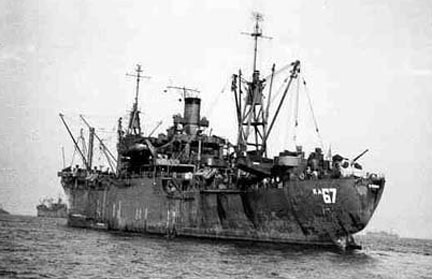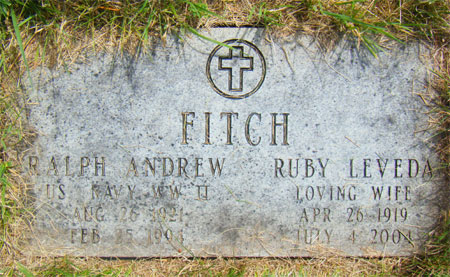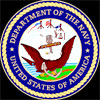 |
North
High School Wall of Honor
Ralph Andrew Fitch
Would have graduated in Class of June, 1939?
|
Fitch |
 |
|
Research done by Claradell Shedd, Class of 1953. PAGE IN PROGRESS |
| Ralph
Andrew Fitch |
| Ralph
would have graduated as member of North High's class of June, 1939,
but he left early to join the US Navy.. His next of kin was Mr. Doss
K. Fitch, 1920 Forest Avenue, Des Moines, IA. Ralph's service number
was 8606237. |
| Ralph Andrew Fitch |
 |
| Year |
|
Rank/Rating |
|
Status |
 |
| June, 1939 |
x |
x |
x |
Would have graduated from
North High, Des Moines, IA |
| 1939-1944 |
|
Employed
|
|
Rissien's Grocery, 13th
and Forest Avenue |
| Apr 26,1940
|
x |
Family |
x |
Married Ruby Leveda Carson |
| Sept 30,1940
|
x |
Family |
x |
Daughter born; Beverley
Carlene Fitch in Des Moines, IA |
| Jan 7, 1942 |
x |
Family |
x |
Daughter born; Sharon
Kay Fitch McClure. Deceased 02/21/13, West Branch, IA |
| May 12,
1944 |
x |
US Navy |
x |
Enlisted in Des Moines |
| May, 1944
|
x |
Training |
x |
One month of Basic Training;
Great Lakes, Illinois |
| 1946 |
x |
Training |
x |
US Navy, Fort Pierce,
Florida |
| date |
x |
Training |
x |
A1B, Hampton Roads, Norfolk,
VA |
| date |
x |
Training |
x |
N1S, Newport, Rhode Island |
Oct 28,
1944
Jan 15, 1946 |
x |
Enroute |
x |
US Navy cargo ship USS
Starr, AKA-67 |
| Dec 31,
1944 |
x |
Duty |
x |
USS Starr, AKA-67; US
Navy Muster Rolls 1938-1949 |
| Jan 20,1945
|
x |
Transferred |
x |
To US Naval Base Hospital
#6; Navy 128. Ralph fell off of the USS Starr. The crew made several
passes to save him from his overboard experience. On the "last
pass", they rescued him. |
| Jan 27,
1945 |
x |
Duty |
x |
USS Starr, AKA-67; US
Navy Muster Rolls 1938-1949 |
| Jun 24,
1945 |
x |
Duty |
x |
USS Starr, AKA-67; US
Navy Muster Rolls 1938-1949 |
| Jan 22,1946
|
x |
Duty |
x |
USS Starr, AKA-67; US
Navy Muster Rolls 1938-1949; San Diego, CA to San Francisco, CA.
V6, USNR to PSC, Minneapolis, MN |
| Jan 24,1946 |
x |
Discharged |
x |
Where? |
| 1946-on |
x |
Employment |
x |
Rissien's Grocery |
| - 1994 |
x |
Employment |
x |
MidAmerican Energy as
an estimator |
| Feb 25,
1994 |
x |
Deceased |
x |
Des Moines, IA |
| aft Feb
25, 1994 |
x |
Buried |
x |
Glendale Cemetery; Memorial
#114809360 , Des Moines, IA |
|
USS
Starr (AKA-67)
USS Starr (AKA-67), the only ship of the United States Navy named
for Starr County, Texas, was a Tolland-class attack cargo ship.
She served as a commissioned ship for 20 months.
Her keel was laid down as a Type C2-S-AJ3 ship
on 13 June 1944 (as MC hull 1392), under Maritime Commission
contract, by North Carolina Shipbuilding Company of Wilmington,
North Carolina. She was launched on 18 August 1944, sponsored
by Mrs. C. L. Griffin and acquired by the Navy from the War
Shipping Administration on a bareboat charter; and was commissioned
on 29 September 1944 with Commander Frederick O. Goldsmith in
command.
Starr completed fitting out at Charleston, South
Carolina, and sailed on 31 October for the Chesapeake Bay on her
shakedown cruise. After loading cargo, she stood out of Norfolk,
Virginia, on 27 November and proceeded, via the Panama Canal,
to the Pacific. She arrived at Pearl Harbor on 18 December 1944
and remained there until after Christmas. Starr participated in
amphibious landing exercises during the first week of January
and then entered Kahului Harbor, Maui, for combat loading.
Starr joined a large convoy and sailed west
on 27 January, stopping at Eniwetok for two days, before proceeding
to Saipan, where the Iwo Jima assault force was staging. The
force cleared Tanapag Harbor on 16 February. At 0640 three days
later, Starr launched her boats against the Iwo Jima beaches.
The attack cargo ship had multiple duties: she was a receiving
ship for wounded; an ammunition ship for Salt Lake City (CA-25);
and she had a priority cargo of vehicles which were to be delivered
only when requested and then, as quickly as possible. She waited
until 25 February to begin discharging her cargo and finished
on 5 March. She then got underway for Leyte.
Starr loaded combat cargo from 9 to 27 March
and joined a convoy for the Ryukyu Islands. On 1 April, her
first boats hit the water at 0615; and they soon joined their
prearranged waves for hitting the Okinawa beaches. At 0420 on
9 April the ship was raked from stem to stern by an explosion.
At first, it was thought that she had been torpedoed; but it
was soon learned that she had been attacked by a Japanese suicide
boat. The suicide boat had exploded as it contacted one of a
cluster of Starr's landing craft that were moored alongside.
The explosion was sufficiently removed from the side of the
ship, and the water absorbed the shock so Starr suffered little
damage.
Starr sailed for Guam on 10 April with a convoy
and was routed onward to Pearl Harbor. She arrived there on
26 April and was notified that she was to return to the West
Coast for overhaul. She arrived at San Pedro, California, on
5 May; and repairs were begun immediately. When they were completed,
the ship participated in an amphibious exercise and then loaded
cargo at San Francisco, California, to be delivered to Guam.
She sailed on 24 June and arrived at Guam on 11 July. On 20
July, she steamed to Pearl Harbor for another load of cargo
for Guam. Starr was several days out of Guam when word was received
that hostilities with Japan had ended.
Post-war activities, 1945–1946. After discharging
her cargo at Guam, the ship was routed to the Philippines on
2 September; she arrived at Leyte on 5 September. Starr operated
in the Philippines until 29 November when she got underway for
China and arrived at Tsingtao on 4 December 1945.
Starr sailed from China to Sasebo, Japan, and
thence to Vladivostok. She arrived there on 2 January 1946,
unloaded her cargo, and returned to Sasebo where she received
orders to proceed, via San Diego, to San Francisco. She remained
at San Francisco from 9 to 18 March and then got underway for
Hampton Roads. Starr arrived at Norfolk, Virginia, on 4 April
1946; was decommissioned on 31 May 1946, and was returned to
the War Shipping Administration on 1 June 1946. She was struck
from the Naval Vessel Register on 19 June 1946.
|
|
 |
 |
| November-Hotel-Golf-Oscaro |
| *Photo
and call signs of USS Starr (AKA-67) |
|
| USS Starr; AKA-67
Awards, Citations and Campaign Ribbons |
 |
Precedence
of awards is from top to bottom, left to right
Top Row - Combat Action Ribbon (9 April 1945, Okinawa) - American
Campaign Medal
Bottom Row - Asiatic-Pacific Campaign Medal (2) -World War II
Victory Medal - Navy Occupation Service Medal (with Asia clasp) |
|
 |
| Buried Glendale Cemetery; Memorial
#114809360, Des Moines, IA |
|

|
Ralph
Andrew Fitch
US Navy
Group/Division
Ralph Andrew Fitch photo
medals |

samples

|
|
| References |
(1)
The World War II Army Enlistment Records contain information on
more than nine million indivdual enlistments. These records can
be found online at http://www.archives.gov/.
(2) The comprehensive list of names from North High's 1893-2018
graduation classes are from Claradell Shedd's North Des Moines
High School website. The names of North High School graduates
can be found online at: http://www.ndmhs.com/.
Ralph Andrew Fitch's class page is: http://www.ndmhs.com/pages/yearclass1939(2005.66).html. |
|
|
Died: 02/25/94. |
| Music:
"Anchors Aweigh" |
Home
|
Back/allyears |
WWI |
WWII |
Korea |
Vietnam |
Afghanistan/Iraq |
Lyrics
|
Refs/Awards |
Contact
©2025-csheddgraphics All rights reserved.
All images and content are © copyright of their respective copyright
owners. |
|





